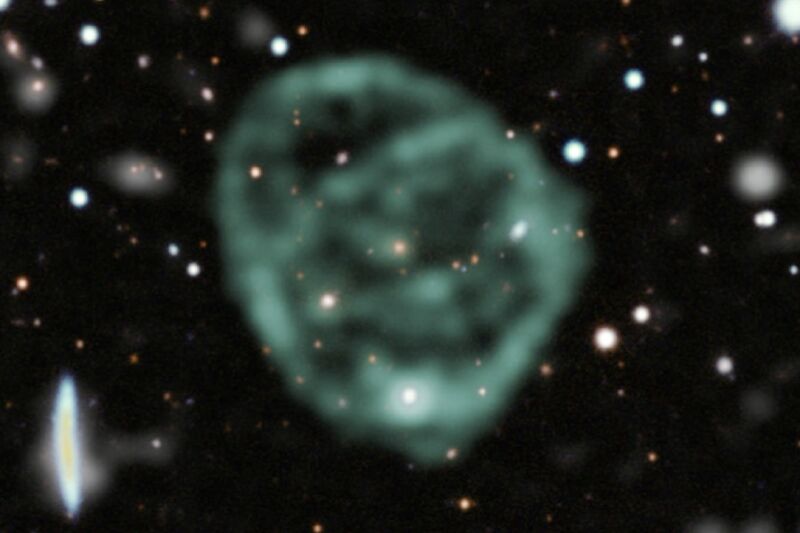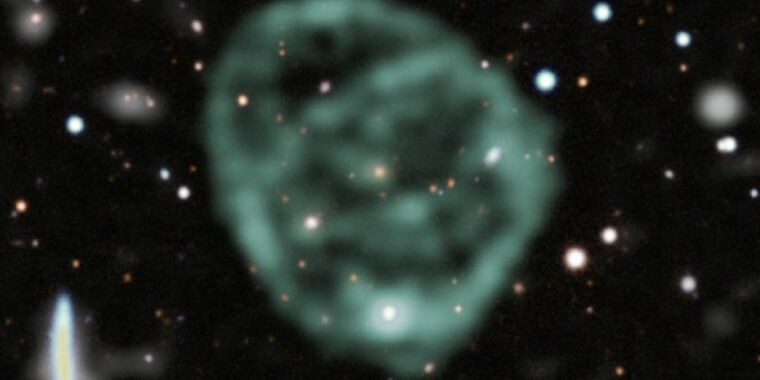Astronomers think they finally know origin of enormous “cosmic smoke rings“
Space oddity —
Massive stars burn out quickly. When they die, they expel their gas as outflowing winds.

Enlarge / Odd radio circles are large enough to contain galaxies in their centers and reach hundreds of thousands of light years across.
Jayanne English / University of Manitoba
The discovery of so-called “odd radio circles” several years ago had astronomers scrambling to find an explanation for these enormous regions of radio waves so far-reaching that they have galaxies at their centers. Scientists at the University of California, San Diego, think they have found the answer: outflowing galactic winds from exploding stars in so-called “starburst” galaxies. They described their findings in a new paper published in the journal Nature.
“These galaxies are really interesting,” said Alison Coil of the University of California, San Diego. “They occur when two big galaxies collide. The merger pushes all the gas into a very small region, which causes an intense burst of star formation. Massive stars burn out quickly, and when they die, they expel their gas as outflowing winds.”
As reported previously, the discovery arose from the Evolutionary Map of the Universe (EMU) project, which aims to take a census of radio sources in the sky. Several years ago, Ray Norris, an astronomer at Western Sydney University and CSIRO in Australia, predicted the EMU project would make unexpected discoveries. He dubbed them “WTFs.” Anna Kapinska, an astronomer at the National Radio Astronomy Observatory (NRAO) was browsing through radio astronomy data collected by CSIRO’s Australian Square Kilometer Array Pathfinder (ASKAP) telescope when she noticed several strange shapes that didn’t seem to resemble any known type of object. Following Norris’ nomenclature, she labeled them as possible WTFs. One of those was a picture of a ghostly circle of radio emission, “hanging out in space like a cosmic smoke ring.”
Other team members soon found two more weird round blobs, which they dubbed “odd radio circles” (ORCs). A fourth ORC was identified in archival data from India’s Giant MetreWave Radio Telescope, and a fifth was discovered in fresh ASKAP data in 2021. There are several more objects that might also be ORCs. Based on this, the team estimates there could be as many as 1,000 ORCs in all.
While Norris et al. initially assumed the blobs were just imaging artifacts, data from other radio telescopes confirmed they were a new class of astronomical object. They don’t show up in standard optical telescopes or in infrared and X-ray telescopes—only in the radio spectrum. Astronomers suspect the radio emissions are due to clouds of electrons. But that wouldn’t explain why ORCs don’t show up in other wavelengths. All of the confirmed ORCs thus far have a galaxy at the center, suggesting this might be a relevant factor in how they form. And they are enormous, measuring about a million light-years across, which is larger than our Milky Way.
As for what caused the explosions that led to the formation of ORCs, new data reported in 2022 was sufficient to rule out all but three possibilities. The first is that ORCs are the result of a shockwave from the center of a galaxy, perhaps arising from the merging of two supermassive black holes. Alternatively, they could be the result of radio jets spewing particles from active galactic nuclei. Finally, ORCs may be shells caused by starburst events (“termination shock”), which would produce a spherical shock wave as hot gas blasted out from a galactic center.

Enlarge / A simulation of starburst-driven winds at three different time periods, starting at 181 million years. The top half of each image shows gas temperature, while the lower half shows the radial velocity.
Cassandra Lochhaas / Space Telescope Science Institute
Coil et al. were intrigued by the discovery of ORCs. They had been studying starburst galaxies, which are noteworthy for their very high rate of star formation, making them appear bright blue. The team thought the later stages of those starburst galaxies might explain the origin of ORCs, but they needed more than radio data to prove it. So the team used the integral field spectrograph at the W.M. Keck Observatory in Hawaii to take a closer look at ORC 4, the first radio circle observable from the Northern Hemisphere. That revealed a much higher amount of bright, heated, compressed gas than one would see in an average galaxy. Additional optical and infrared imaging data revealed that the stars in the ORC 4 galaxy are about 6 billion years old. New star formation seems to have ended some billion years ago.
The next step was to run computer simulations of the odd radio circle itself spanning the course of 750 million years. Those simulations showed an initial 200-million-year period with powerful outflowing galactic winds, followed by a shock wave that propelled very hot gas out of the galaxy to create a radio ring. Meanwhile, a reverse shock wave sent cooler gas back into the central galaxy.
“To make this work, you need a high-mass outflow rate, meaning it’s ejecting a lot of material very quickly. And the surrounding gas just outside the galaxy has to be low density, otherwise the shock stalls. These are the two key factors,” said Coil. “It turns out the galaxies we’ve been studying have these high-mass outflow rates. They’re rare, but they do exist. I really do think this points to ORCs originating from some kind of outflowing galactic winds.” She also thinks that ORCs could help astronomers understand more about galactic outflowing winds since it enables them to “see” those winds through radio data and spectrometry.
Nature, 2024. DOI: 10.1038/s41586-023-06752-8 (About DOIs).
Astronomers think they finally know origin of enormous “cosmic smoke rings“ Read More »
